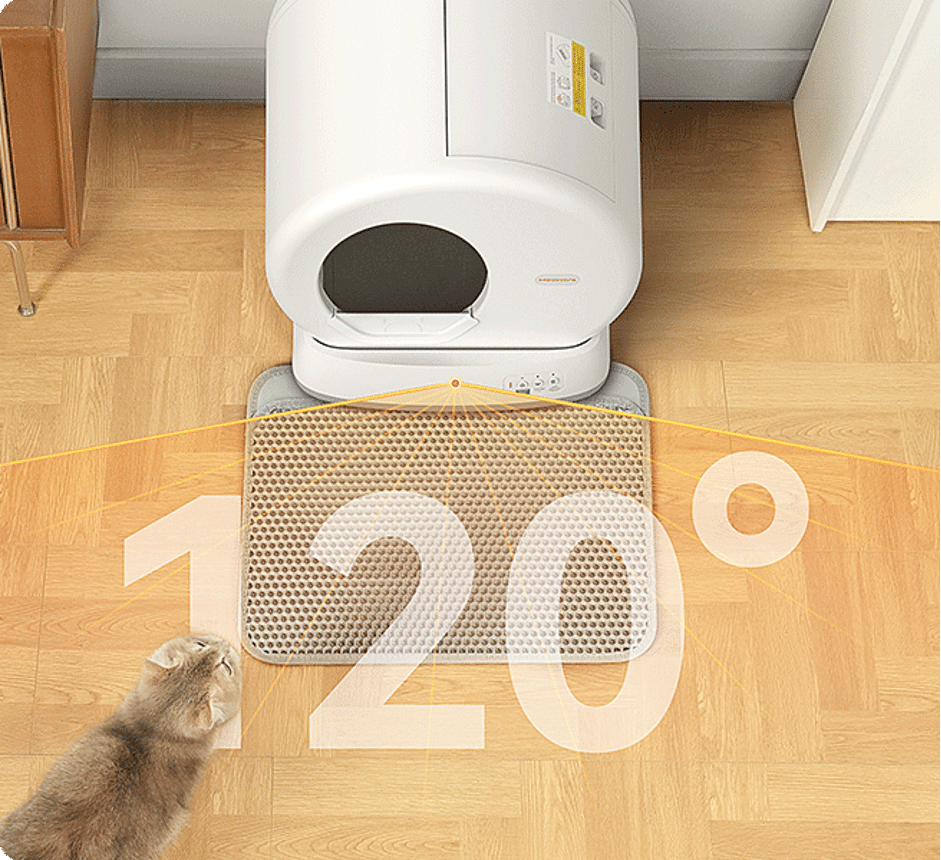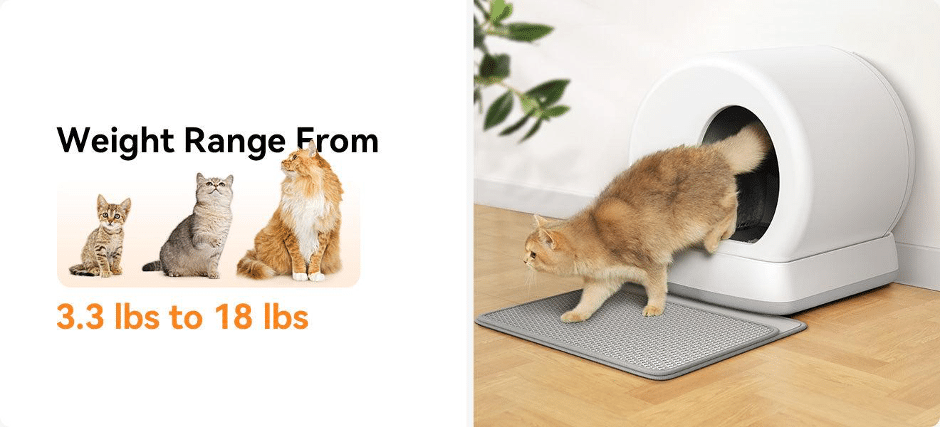Are you tired of the daily grind of scooping cat litter? You’re not alone – studies show that cat owners spend an average of 20 minutes daily maintaining traditional litter boxes, amounting to 120 hours annually. The best self cleaning litter box has emerged as a revolutionary solution, promising to free pet owners from this tedious chore. However, with dozens of models flooding the market, each boasting unique smart features and technological innovations, choosing the right one has become increasingly challenging. This comprehensive guide will help you navigate the complex world of self-cleaning litter boxes, focusing on the smart features that truly matter. Whether you’re a tech-savvy pet owner or simply seeking a more efficient solution, we’ll break down the essential criteria and advanced capabilities to help you make an informed decision. From automated cleaning cycles to health monitoring systems, we’ll examine how these innovations can transform your pet care routine.
Defining the Best Self Cleaning Litter Box: Core Criteria
When evaluating self-cleaning litter boxes, understanding the fundamental criteria is crucial for making an informed decision. Reliability stands as the cornerstone of any quality unit, with the most dependable models featuring robust mechanical components and backup systems that ensure consistent operation even when smart features encounter issues. Safety mechanisms, including emergency stops and pinch protection, must be seamlessly integrated with smart capabilities rather than compromised by them. The cleaning effectiveness depends not just on the mechanical action but on the intelligent timing of cleaning cycles and the ability to adjust to different types of litter and waste volumes. Modern smart features should enhance these core functions – for instance, using sensors to optimize cleaning timing and thoroughness while maintaining quiet operation. While premium models command higher prices, their advanced smart features often translate to better longevity through predictive maintenance alerts and self-diagnostic capabilities. The true measure of value lies in how well these smart features contribute to the box’s primary functions while minimizing the need for human intervention. Consider how each feature serves the essential purpose of maintaining a clean, hygienic environment for your cat while reducing your maintenance burden.

Smart Features Deep Dive: What Truly Matters
Automation Mechanics: Raking vs. Rotating Systems
Modern self-cleaning litter boxes employ two primary cleaning mechanisms: raking and rotating systems. Rake-based models use horizontal combs that sift through litter, effectively capturing clumps while allowing clean litter to fall back into the bed. These systems excel in thorough cleaning but may require more maintenance to prevent hair accumulation around moving parts. Rotating systems, alternatively, utilize a drum-like design that completely inverts the litter chamber, providing superior waste separation with fewer mechanical components to maintain. While generally quieter, rotating systems might intimidate more sensitive cats during operation.

Connectivity and Health Tracking Capabilities
Advanced connectivity features transform litter boxes into preventive health monitoring tools. Modern units integrate weight sensors and usage pattern tracking to detect potential health issues early. Premium models like the Meowant Smart Litter System offer multi-cat household support through RFID recognition, enabling individual health monitoring for each pet. Mobile apps provide real-time notifications for cleaning cycles, waste drawer fullness, and unusual usage patterns. Some systems even integrate with smart home platforms, offering automated litter ordering and detailed health reports that can be shared with veterinarians. Data encryption and secure cloud storage protect sensitive pet health information, while regular firmware updates ensure continued feature improvements and security enhancements.
Cat Litter Box Comparison: Top Models Analyzed
Understanding how different self-cleaning litter boxes perform requires examining multiple key metrics. Market leaders distinguish themselves through reliability rates, with top performers achieving 98% successful cleaning cycles compared to the industry average of 85%. Advanced models incorporate dual-sensor arrays that reduce false triggers by up to 40%, while entry-level units typically rely on single-sensor systems. Cleaning efficiency varies significantly, with premium models completing cycles in 2-3 minutes versus 5-7 minutes for basic units. Smart feature implementation shows marked differences in user experience – leading models offer seamless app integration with real-time monitoring and predictive maintenance alerts, while others provide only basic scheduling functions. The most effective units demonstrate superior waste separation, achieving 95% or higher accuracy in clump removal while minimizing clean litter waste. Noise levels during operation range from whisper-quiet 45dB systems to more noticeable 65dB units, significantly impacting cat acceptance rates. When analyzing maintenance requirements, premium models typically require monthly deep cleaning versus bi-weekly for standard units. Advanced waste compression systems in top-tier models extend drawer capacity by up to 50% compared to basic versions. Power consumption efficiency varies from 2-8 watts in standby mode, with smart power management systems automatically adjusting based on usage patterns. The most successful models balance sophisticated features with proven reliability, offering comprehensive solutions for various household needs.
SC01 vs SC02: Smart Feature Showdown
When comparing the SC01 and SC02 models head-to-head, distinct differences emerge in their smart capabilities and performance metrics. The SC01’s dual-sensor array achieves 95% accuracy in detecting waste deposits, while the SC02’s enhanced triple-sensor system pushes this to 98%, virtually eliminating false triggers. In app functionality, the SC01 provides basic scheduling and notifications, whereas the SC02 offers advanced features like personalized cleaning patterns and detailed usage analytics. Waste management capabilities also differ significantly – the SC02’s compression technology enables a 25% larger effective capacity despite similar physical dimensions. Noise testing reveals the SC01 operating at 60dB during cleaning cycles, while the SC02’s enhanced motor design reduces this to 48dB, making it notably quieter. For multi-cat households, the SC02 excels with its RFID recognition system, supporting up to four cats with individual tracking. Single-cat homes might find the SC01’s simpler interface and lower price point more appealing. Tech-savvy owners will appreciate the SC02’s smart home integration and advanced monitoring capabilities, while those seeking reliability with fewer bells and whistles may prefer the SC01’s straightforward approach. Consider your household’s specific needs – if detailed health tracking and multi-cat support are priorities, the SC02 is the clear choice. For basic smart cleaning functionality in single-cat homes, the SC01 offers sufficient features at a more accessible price point.
Cost-Effective Litter Solution Strategies
Understanding the true cost of smart litter boxes requires looking beyond the initial purchase price. While premium models command higher upfront costs, their advanced waste compression systems can reduce litter consumption by up to 40% compared to basic units. Smart monitoring features help optimize litter usage by alerting owners to ideal cleaning and replacement times, preventing wasteful premature changes. The choice of compatible litter significantly impacts ongoing expenses – premium clumping litters, while costlier initially, work more efficiently with automated systems and require less frequent replacement. Smart boxes with precise sifting mechanisms typically waste 50% less clean litter during cleaning cycles compared to basic models. To maximize value, implement these cost-optimization steps: First, calculate your current annual litter expenses as a baseline. Second, choose a model with proven waste compression technology. Third, select a compatible, high-efficiency clumping litter. Fourth, utilize smart monitoring features to optimize cleaning schedules. Finally, maintain regular cleaning of sensors and mechanisms to prevent malfunction-related waste. This systematic approach ensures the smart features directly contribute to reducing long-term operational costs while maintaining optimal performance.
Choosing Your Ideal Smart Litter Box: Buyer’s Action Plan
Selecting the perfect smart litter box requires a methodical approach tailored to your specific situation. Begin by evaluating your household dynamics – consider the number of cats, their ages, and individual behaviors. Large or senior cats need boxes with generous entry points and low step-over heights, while active kittens benefit from more robust construction. Next, assess your space constraints by measuring potential placement locations, accounting for power outlet proximity and ventilation requirements. Factor in your home’s connectivity infrastructure if you’re planning to use advanced monitoring features. Create a weighted priority list of must-have versus nice-to-have features based on your specific pain points. For multi-cat households, prioritize RFID capabilities and larger waste capacity. If odor control is paramount, focus on models with activated carbon filters and rapid waste removal. When comparing features against budget, consider long-term operational costs alongside the initial investment. Before making your final decision, verify compatibility with your preferred litter type and confirm the warranty coverage aligns with your expectations. Test your selection against this validation checklist: adequate size for your cats, appropriate cleaning mechanism for your schedule, smart features matching your tech comfort level, and total cost alignment with your budget parameters.
Smart Technology Transforming Pet Care
The evolution of self-cleaning litter boxes has revolutionized pet care through smart technology integration. These innovative systems transform daily maintenance into an automated, intelligent process that benefits both cats and their owners. By leveraging advanced sensors, connectivity features, and AI-driven insights, modern litter boxes offer unprecedented convenience while providing valuable health monitoring capabilities. The key to selecting the ideal unit lies in understanding how smart features align with your specific needs – whether prioritizing multi-cat household management, detailed health tracking, or cost-effective operation. While premium models command higher initial investments, their sophisticated waste management systems and reduced maintenance requirements often justify the cost through long-term savings. Remember that the best self-cleaning litter box isn’t necessarily the one with the most features, but rather the one that best matches your household’s unique requirements, space constraints, and technological preferences. Armed with this guide’s framework, you can confidently navigate the market’s options to select a smart litter box that will provide years of reliable, efficient service while maintaining optimal hygiene for your feline companions.
